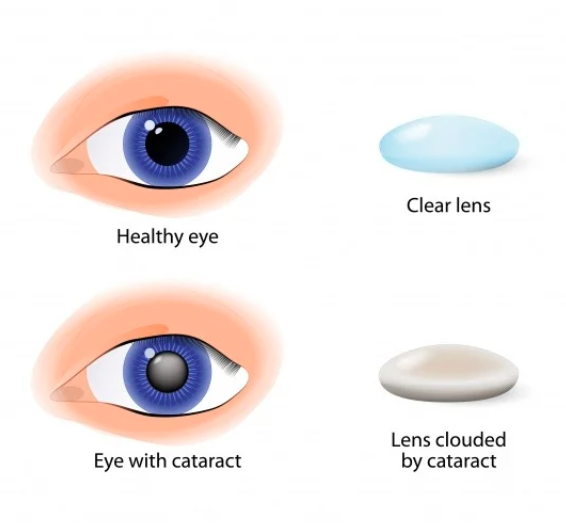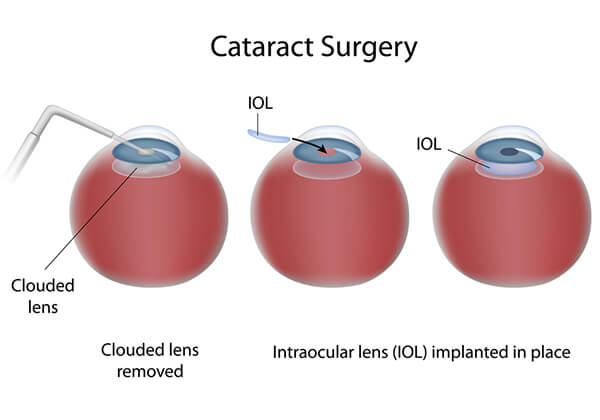What is a Cataract
We are born with a perfectly clear, flexible crystalline lens. With age the lens hardens. Usually around age 40+, this hardening leads to a loss of near vision (presbyopia) and signals the need for reading glasses or a bifocal lens.
As the lens continues to harden it loses its clarity, and develops imperfections that begin to affect the quality of vision (this imperfect or aging lens is a cataract). If not treated, a cataract will progress to impair the vision and eventually can lead to blindness.

How do I know if I have a Cataract?
- Symptoms that may indicate a maturing cataract may include the following:
- Glare or halos at night
- Trouble driving at night
- Blurred vision
- Frequent changes in your glasses prescription
- Difficulty distinguishing colors
- Trouble reading fine print
- Difficulty reading road signs
- Other noticeable changes in the quality of your vision
When do I need Cataract Surgery?
Cataracts grow slowly and are diagnosed long before symptoms start or treatment is needed. Eventually as the cataract “matures,” symptoms worsen, and surgery is recommended. The decision for cataract surgery is one that the patient and doctor will make together. Some patients have a high tolerance for imperfections in their vision and will wait longer for surgery than others who are affected by minor visual disturbances. The good news is that there is rarely any need to rush into cataract surgery and the procedure can usually be scheduled at your convenience.
Fortunately, advances in cataract surgery have made this procedure not only one of the safest, but one of the highest rated in patient satisfaction in all of medicine. While outcomes are almost universally good, cataract surgery is a major surgery, is not risk free, and complications can occur.
What is Cataract Surgery?
Cataract surgery involves removing the lens (cataract) and replacing it with an intraocular lens implant. Cataract surgery is typically performed through a small incision that does not usually require sutures. The surgery typically takes less than 20 minutes and you can expect to stay in our Coeur d’Alene surgery center for up to three hours. Patients tell us the procedure is comfortable and the overall experience is pleasant and life changing.

What are my Lens Options?
Our surgeons offer a full line of intraocular lenses designed to correct a range of vision problems:
(LAL, Monofocal, Toric, and Multifocal Lenses).
Light Adjustable Lens (LAL)
The Light Adjustable Lens is a groundbreaking, specialized lens that is adjustable after surgery. Using specialized light treatment, the LAL can be refined to optimize the vision of each individual.
The Advantages of LAL
- Tailored Precision: Every eye is different, and with LAL, patients aren’t limited to a single solution. After the implantation, adjustments can be made to the lens, ensuring vision clarity matches each individual’s lifestyle and requirements.
- Reduced Dependence: LAL’s precision often decreases the need for corrective lenses after the operation, giving many a level of freedom they haven’t experienced in years.
- Safe and Swift: Patients can expect a procedure that is not only efficient, but also has a quick recovery time compared to traditional surgeries.
MonoFocal Lenses
A monofocal lens can be customized to give clear vision at a single distance without glasses in most eyes. If a distance target is chosen, reading glasses will be needed. If a near target is chosen, distance glasses will be needed. If astigmatism is present, glasses will be needed for distance and near after cataract surgery.
Generally fully covered by Insurance
Toric Lenses
A toric lens is needed to achieve clear vision without glasses in patients with significant amounts of astigmatism. Toric lenses will correct either distance vision or near vision without glasses in most eyes, but not both. Toric lenses are recommended in patients with significant astigmatism, but are optional given the added out-of-pocket expense.
Additional cost – Not covered by Insurance
MultiFocal Lenses and MultiFocal Toric Lenses
Multifocal lenses have the advantage of correcting distance vision and some near vision without glasses. While glasses will likely still be needed for some tasks, a multifocal lens gives some degree of glasses independence at both distance and near. Not all eyes are candidates for a multifocal lens and certain conditions prevent the multifocal lens from performing as designed. Your surgeon will help you understand if you are a candidate for a multifocal lens.
Additional cost – Not covered by Insurance







